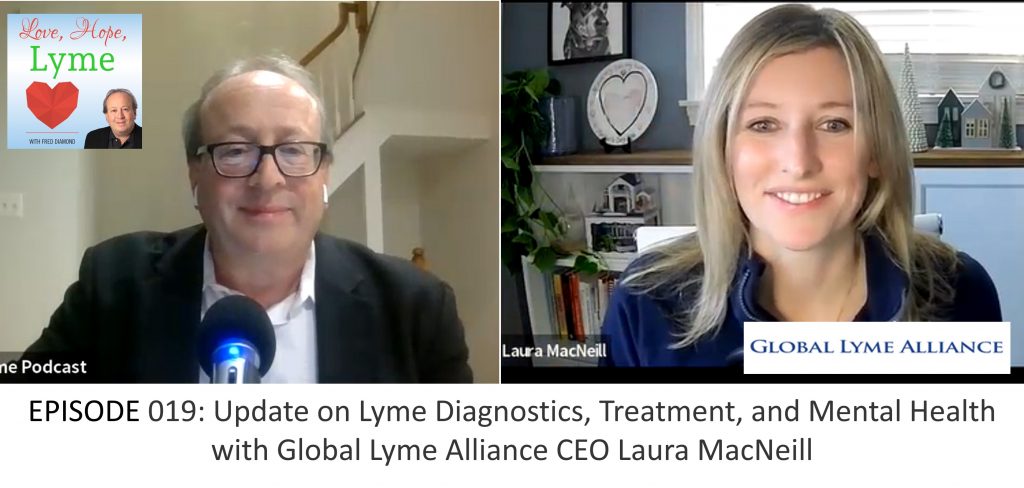PODCAST: Lyme diagnostics and treatment updates

By Fred Diamond
On this week’s Love, Hope, Lyme podcast, Global Lyme Alliance (GLA) CEO Laura MacNeill shares some developments in Lyme disease diagnostics, treatment, and mental health care that her organization is supporting.
When I was doing the research for my book “Love, Hope, Lyme: What Family Members, Partners, and Friends Who Love a Chronic Lyme Survivor Need to Know,” I didn’t know how much advocacy organizations such as Lymedisease.org and GLA are doing on behalf of the Lyme community.
Since then, I’ve been fortunate to have discussed their missions with many of them and look forward to bringing more of them on the podcast.
Diagnostic improvement is sorely needed
“Lyme disease can manifest in a wide range of flu-like symptoms, physical impairments, heart issues, depression, and suicidal ideation, just to name a few,” MacNeill told me. “This underscores the need that we have as a community to have improved awareness, diagnostics, and treatment.
“A lot of people have been suffering in silence for decades. The current diagnostic that we use today, for instance, was created when we were using typewriters. There has been very slow progress in this disease space. I believe that there’s a lot shifting, especially on the heels of COVID-19,” she declared.
Despite its prevalence, she said, Lyme disease receives disproportionately lower funding than other infectious diseases. There are more cases reported annually than HIV/AIDS, West Nile virus, and malaria combined, but Lyme receives only a fraction of the research funding allocated to these diseases. The funding gap hinders scientific advancements, increases the healthcare cost, and the suffering grows.
“That’s where Global Lyme Alliance was born. We are trying to shorten the gap between viable innovative research that can happen today, and helping the patients that are suffering, as well as their loved ones that are lost in the medical system and trying to navigate this themselves.”
She said that a major priority of GLA is helping to fund better diagnostics.
Delayed diagnosis
“Current diagnostics can miss up to 60% of early-stage Lyme disease cases. The Lyme disease world lacks a universal diagnostic method, so treatment options are limited or unproven,” she said. “The longer it takes to get properly tested for Lyme, the more challenging it will become to treat.”
She said that her team attends and hosts research gatherings that foster collaboration and sharing of data. At one such gathering, the GLA team attended a presentation by Dr. Brandon Jutras of Virginia Tech on his team’s goal of creating a rapid, at-home test that can diagnose acute Lyme disease.
In developing an acute test to treat Lyme disease, a team in the Jutras Lab will use peptidoglycan, a component forming the cell walls of many bacteria, as a biomarker of acute disease. The goal is to develop a sophisticated but very accessible test that can exploit these unusual molecular signatures to directly detect this molecule and in essence be able to hopefully diagnose Lyme disease within hours after infection.
Virtually all bacteria have the cell-wall component peptidoglycan. But, the peptidoglycan of the Lyme disease bacterium is unique. The Jutras lab is developing methods focused on using peptidoglycan as a marker for new diagnostic tests for Lyme disease. Their research now includes using anti-peptidoglycan antibodies to improve existing diagnostics.
MacNeill said, “Dr. Jutras’s goal is to develop a direct diagnostic test that can identify this molecule within hours of infection…Such a test would launch us into the next era of Lyme disease diagnostics and drive us towards fulfilling our mission to improve these diagnostic tests.”
“They’re theorizing right now that strategies to destroy the peptidoglycan may [also] be of therapeutic benefit for those suffering from chronic Lyme disease. We’re proud to be funding Dr. Jutras and be at the forefront of his promising work,” she said.
Treatment developments
A second area GLA is focused on is funding the development of better treatment options for Lyme disease.
“There’s no FDA-approved treatment for chronic Lyme disease today,” she said. “Initially, you’re most likely going to be afforded a strong antibiotic, something like doxycycline. But, doxycycline, which can be very effective in the early stage of infection, is not very effective if this bacterium has gotten pervasive in your system.”
In 2015, GLA funded a drug discovery program with Dr. Kim Lewis at Northeastern University, to determine how an antibiotic called Hygromycin A can be used to prevent chronic conditions. Building on this discovery, GLA partnered with Dr. Lewis and the biotech company Flightpath Biosciences, to test how well this could work.
“We’re excited to announce that hygromycin A is moving into the clinical stage. In January 2024, they’re going to start the first stage of human clinical trials with a healthy cohort in Australia.”
“The first stage is to determine if Hygromycin A is safe for people who do not have the infection. This should be a short trial over there. They’re looking at maybe six to eight weeks. Once they’ve proven that this is safe and effective for people that aren’t sick, they can move the trial into the United States and several other countries, and then they can take on patients who have been impacted by Lyme disease. We are eagerly anticipating progress on the road ahead.”
Addressing mental health challenges
MacNeill said that of all the projects they are funding, one of the most important addresses mental health assistance to Lyme survivors.
She discussed a Danish study that was done over 22 years which collected data from nearly seven million people that showed the mental health impact from Lyme disease.
“It was long suspected that Lyme disease may increase the risk of psychiatric disorders, including depression and suicidal ideation. A groundbreaking study led by a team in Copenhagen collected data of almost seven million people over a 22-year span. This population’s universe included more than 12,000 people that were diagnosed with Lyme disease,” she said.
MacNeill said the study found that with a single diagnosis of Lyme disease, there’s a 24% increased risk of a mental disorder, including depression. With two or more episodes of Lyme disease, that risk increases to 79%. Moreover, people with Lyme disease have a two-fold higher risk of dying by suicide than those without Lyme disease. The elevated risk of mental disorders was highest in subjects that were in the age range of 20 to 29, suggesting that vulnerability of young people who are impacted.
Based on the results, the lead investigator said that medical practitioners and patients should be aware of an increased risk of mental health problems, particularly the first year after a severe Lyme disease infection.
“If you’re noticing a change in someone that you care about, this could be directly related to their Lyme disease bacterial infection, and you should go out and seek treatment immediately,” she said.
Click here to listen to all episodes of the Love, Hope, Lyme Podcast or on YouTube.
Fred Diamond is based in Fairfax, Virginia. His popular book, “Love, Hope, Lyme: What Family Members, Partners, and Friends Who Love a Chronic Lyme Survivor Need to Know” is available on Amazon. The pdf-version of the book is always free to Lyme survivors. Please send Fred a message via Facebook for your copy. He gladly accepts Facebook friend requests from the Lyme community.





















We invite you to comment on our Facebook page.
Visit LymeDisease.org Facebook Page